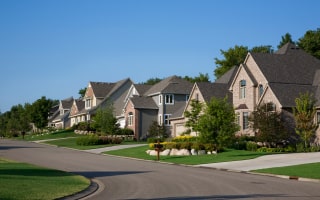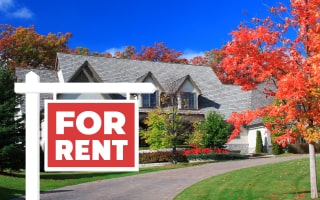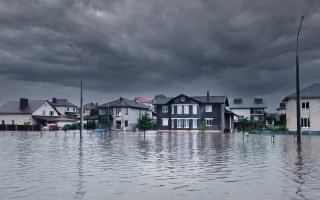Homeowners Insurance in Minnesota

Minnesota is located in the Midwest and the heart of natural weather disasters. The state is known for violent tornadoes, earthquakes, wildfires, and flooding. Although parts of Minnesota are relatively safe, others experience frequent turbulence, and residents' homes get damaged, and they file claims. Since 1953, Minnesota has had 60 federally declared disasters, and the rate of disasters per 1 million people is 10.41.
Flooding/water damage, hail, and wind damage are the three main reasons for claims in Minnesota. In addition to weather events, Minnesota residents also file claims for theft, vandalism, and liability concerns.
Because states don't require any homeowners insurance, you might think coverage limits don't matter. But, if you finance your house purchase, your lender will demand that you buy coverage and dictate specific coverage limits. You will have to keep those limits in place for the duration of the loan.
As of late 2024, the national average for homeowners insurance is $2,511. In Minnesota, homeowners pay an average of $1,829 for $200,000 in dwelling coverage. That is slightly less than the national average.
Types of Homeowner Insurance Coverage Available in Minnesota
Every U.S. state has insurance providers who offer specific coverages within the state based on the risk factor, claims history, and other details. Some states have more carriers, and others have limited options. The available types of coverage in Minnesota are as follows:
-
Dwelling: Dwelling coverage protects the structure of your home (foundation, walls, roof, etc.) and pays to repair or replace it if a qualifying event occurs.
-
Other Structures: Insurance for other structures pays to replace detached items like sheds, pools, hot tubs, garages, and fences.
-
Liability: If someone gets hurt on your property (due to your negligence), like falling on icy steps, and they sue you, liability insurance will pay your legal bills up to a specific limit.
-
Medical Payments: When a person is injured on your property, medical payments will pay their medical bills.
-
Personal Property: Personal property coverage pays to replace your belongings if they are destroyed or stolen.
-
Additional Living Expenses (ALE): If your home is unlivable after a covered peril and you must move out while it is repaired, ALE insurance pays for your expenses (food, lodging, laundry, etc.).
Since all property insurance has limits, you may consider an umbrella policy to handle overflow expenses. Minnesota residents also deal with frequent flooding, so consider a special policy for that as well.
FEMA (Federal Emergency Management Agency) manages the National Flood Insurance Program (NFIP) through a network of 50 providers across the U.S.
Since most homeowners insurance does not cover floods, this supplemental coverage can repair damage and replace items after a flood. Depending on the options you choose, it can cover the building and/or your personal belongings. This program is available to homeowners, renters, and businesses. Learn more about the program on FEMA's website.
Home Insurance and Natural Disasters
Climate change is a big problem for the home insurance industry. Severe weather caused by global warming is the main driver for insurance rates today. Wildfires and storms are the most significant issues causing more frequent claims and losses. Across the country, home insurance rates have spiked an average of 34% and even as high as 60% in some areas. In Minnesota, rates have increased by 39.1% from 2018 to 2023.
Tornadoes, earthquakes, wildfires, and floods plague Minnesota. In 2023, Minnesota had 25 tornadoes and 713 wildfires, destroying 3,715 acres of land. A single fire claim costs insurers $77,340. From 1980 to 2024, Minnesota had 58 billion-dollar disasters. From 2015 to 2019, Minnesota insurance providers lost a total of $1,360,476,400. Minnesota is high on the list of claims due to hail damage, and from 2017 to 2019, state insurers lost 150,673 due to hail.
How Can I Save on Homeowner Insurance Premiums in Minnesota?
As home insurance premiums continue to rise, the key to finding ways to save is knowing what affects your home insurance rates. Some of the most common factors that impact your home insurance costs include:
-
Location of the Home: The most important factor is the location of your home. If you live in an area prone to wild weather, like frequent hurricanes or tornadoes, or if you live in a high-crime area like the city, your rates will be much higher than those of someone who lives in a mild-weather area with low crime.
-
Size of the Home: The larger the home, the more expensive it will be to rebuild and the higher your rates.
-
Condition of the Home: Well-maintained homes cost less to insure than those in poor condition with old infrastructure, which poses more risk.
-
Financed or Owned: If you own your own home, your rates will be cheaper, and you can choose how much coverage you need. If you finance your home, your lender will choose the coverage levels.
-
Coverage Levels: The more coverage you purchase, the higher your rates will be.
-
Deductible: The lower your deductible, the higher your rates will be, and vice versa.
-
Claims History: If you have many claims on your file, your rates will be higher (even as much as 20% higher after one claim) than those without any claims.
-
Cost of Materials and Labor: As the costs of materials and labor increase, so do insurance rates. Your rates may be lower if your home is built with fire-retardant code-compliant materials.
-
Credit Score: People with good credit scores earn better rates than those with poor credit.
-
Risk Factor: If your property has many risks, such as a pool, hot tub, trampoline, or treehouse, you will pay more than if it doesn't.
Some tips on how to save on homeowners insurance include:
- Make Your Home Storm-Resistant: Minnesota is at risk of dangerous windstorms and wildfires. To lower your rates, install storm-ready windows, a stronger roof and siding, and other protections.
- Avoid Adding Risks: To save on your insurance, don't add things like pools, hot tubs, or trampolines.
- Raise Your Deductible: Increase your deductible as much as possible to lower your insurance rates.
- Boost Your Credit Score: Improve your credit over time and then ask your carrier to re-evaluate your rates.
- Bundle Policies: Bundle your home and auto policies together to get better rates.
- Add Home Security: To lower your rates, install a home security system to prevent theft and vandalism.
- Smart Home Devices: Install smart home devices that monitor for fire, water, and other things that can damage your home.
- Home Improvements: Make minor home improvements to avoid damage and claims.
- Don't File Claims: Don't file many small claims. Wait for something big before you file a claim.
- Shop Around: Shop around before deciding on an insurance company, read reviews, and ask for recommendations.
- Ask for Discounts: Ask your provider for any available discounts you might qualify for.
Home Insurance Discounts in Minnesota
Homeowners insurance is a policy that protects your home against covered perils. If your house burns down in a fire or is destroyed by a hurricane, the insurance company will pay to rebuild it. Homeowners insurance also includes personal property protection, liability coverage, other structures, medical payments, and ALE coverage. Each policy has limits on specific items and will only pay out according to those limits. There are two main types of coverage: "replacement value" and "actual cash value". Actual cash value considers depreciation and may not give you enough to rebuild your home.
You can easily purchase home insurance by contacting a well-known company and applying for a policy. Call their 800 number or apply online using their website. You could also contact a local agent, who can help you decide on coverage limits.
The most common home insurance discounts offered by reputable insurance firms include:
- Occupational Discount: Some insurance providers offer discounts to professionals in certain occupations, such as teaching and firefighting.
- Non-smoker Discount: Non-smokers have a lower risk of fire and, therefore, get a discount on their home insurance.
- Bundling Discount: Bundling policies can earn you a big discount with some carriers.
- Senior Discount: Many carriers offer discounts to senior citizens.
- Military Discount: Military personnel and veterans pay less for their home insurance than others.
- Loyalty Discount: Stay with the same company for years; they usually discount you at specific intervals.
- Paperless Discount: Go paperless with your monthly statements and earn a discount from your provider.
- Autopay Discount: Sign up for autopayments to shave some money off your rates.
- Home-Security Discount: Install a high-end security system to keep out vandals and thieves and get a discount on your insurance.
- Fire-Safety Discount: Install fire safety features like sprinklers and smoke alarms to save money on your insurance.
- New Home Discount: New homes cost up to 40% less to insure than older homes.
Common Rates Offer by Homeowners Insurance Firms
New homes cost significantly less to insure than older homes, up to 40% in some cases. The average cost of home insurance on a new home in Minnesota is $1,829 per year or $152 a month. Actual rates will vary based on many things, such as your age, the age and condition of the house, your credit score, and location.
Top 10 Home Insurance Firms in Minnesota and Average New Home Savings
| Company | % savings |
|---|---|
| Nationwide | 76% |
| State Farm | 51% |
| Liberty Mutual | N/A |
| Travelers | 63% |
| Chubb | N/A |
| Allstate | 47% |
| USAA | 54% |
| American Family Insurance | 55% |
| Amica Mutual | N/A |
| Assurant | N/A |
Home Insurance and Renovations in Minnesota

Home renovations and upgrades can enhance the beauty and warmth of your home but will also impact your home insurance rates. Some upgrades will increase your rates by raising the value of your home or the risk factor. Other upgrades may decrease your rates by making your home safer. A few may both increase and lower your rates, canceling out the effect.
![]() Home Renovations that Increase Rates
Home Renovations that Increase Rates
Some home renovations that increase your rates include:
- Finishing Your Basement: Finishing a basement can almost double your square footage but can also increase your house's value and your insurance rates.
- Bath/Kitchen Upgrades: Upgrading your kitchen or bath adds a lot of value to your home and increases your insurance premiums.
- Solar Panels: Solar panels could help you save thousands on energy bills, but they are pricey to replace and will increase your insurance expenses.
![]() Home Renovations that Decrease Rates
Home Renovations that Decrease Rates
Some home renovations that decrease your rates include:
- Storm-Resistant Roof: Installing a new storm-resistant roof that better withstands storms can help lower your insurance costs.
- Hurricane Straps/Ties: Fortifying your home with hurricane straps and ties could help avoid claims and keep your home safer. These reinforcements could also help you save on insurance.
- Upgrade to Storm Windows: Storm or shatterproof windows are a good idea, especially in Minnesota, where tornadoes and windstorms are prevalent. They can also help you save money on your home insurance.
Installing a new roof will generally lower your insurance rates unless you upgrade using high-end, expensive materials, in which case they might increase.
Upgrades and home renovations are not paid for through your home insurance. Homeowners policies only pay to repair or replace the home after a qualifying event. If you make regular maintenance updates, you must pay for them yourself. However, if someone steals something or gets injured during the renovation, those things are covered by your policy.
Always speak to your insurance agent before making any upgrades. You must check how they will impact your coverage and your rates. Your agent may need to examine the completed work to help you make adjustments afterward.
Minnesota Renters' Insurance

Minnesota renters also need homeowners insurance, but it works differently. Renters insurance does not include any dwelling coverage. The landlord must cover the dwelling themselves with their own homeowners policy. Instead, renters insurance mainly covers personal property and replaces your belongings if they get destroyed (in a fire or other covered peril) or stolen. Renters' policies also include liability protection, medical payments, and loss of use coverage.
Some covered events include:
-
Fire
-
Smoke
-
Lightning
-
Explosions
-
Break-ins
-
Vandalism
-
Windstorms
-
Water Damage
Some things renters insurance will replace are:
-
Clothing
-
Furniture
-
Electronics
-
Sports Equipment
-
Small Appliances
-
Bedding
-
Bath Items
Renters insurance is priced based on three main factors and some others. The three main items are:
-
Location: Your rates will be higher if you live in a city or an area prone to natural disasters.
-
Coverage: The more coverage you purchase, the higher your rates.
-
Number of Units: Typically, the more units in your building, the lower your rates.
Minnesota renters pay an average of $200/year or $17/month for personal belongings coverage of $40,000 and $100,000 in liability coverage with a $1,000 deductible.
Condo Insurance in Minnesota

Minnesota condo owners also need home insurance to protect their investments. Condo insurance, or HO-6 insurance, is slightly different from homeowners insurance. Unlike renters insurance, which has no dwelling coverage, condo insurance does, but it is limited. Every condo association has a master policy that includes dwelling coverage that protects the structure of each building. If destroyed by fire, the master policy will pay to rebuild it back to its original condition. However, any interior upgrades that owners have made, like appliances, cabinets, countertops, flooring, and light fixtures, would not be covered under the master policy. That is where HO-6 insurance comes in and restores everything from the walls in, back to its current condition. Another difference between homeowners and renters insurance is that condo insurance liability coverage only works if the person is hurt inside the condo, not on the common grounds.
Condo insurance also includes liability protection, personal property coverage, medical payments, loss assessment, and loss of use coverage. In the event of damage due to storms, fire, or vandalism and theft, condo insurance will replace:
- Interior Walls
- Appliances
- Flooring
- Cabinets
- Countertops
- Light Fixtures
- Wiring
- Plumbing
- Personal Belongings
The average rate for condo insurance in Minnesota is $423 per year, or $35 a month for $60,000 in personal property, $300,000 in liability protection, and a $1,000 deductible. The national average is $625/year, making Minnesota a relatively affordable state.
You can save on condo insurance by doing the following:
- Bundle Your Policies
- Increase Your Deductible
- Shop Around for Rates
- Make Your Home Safer
- Remove Risks
- Ask for Discounts
Minnesota Home Insurance Market
Minnesota home insurance providers are in real trouble. For the past five years, insurers have sustained massive losses. It's the only state where that occurred, and those losses have quadrupled from 2014 to 2023. With consistent turbulent weather events in Minnesota, this trend is expected to continue and even worsen. Some providers are choosing to stop offering coverage in the state, limit coverage, or even cancel certain customers, making it more difficult for residents to find protection.
Minnesota is a cornucopia of disasters, including tornadoes, earthquakes, wildfires, and floods that cause devastating damage, claims, and losses. Insurers are wise to start limiting coverage in some areas. Eventually, some insurance providers may go bankrupt and slim the competition even further within the state.
No federal agency regulates the home insurance market. However, each state appoints a department to monitor providers and rates, investigate customer complaints, and sanction guilty firms. In Minnesota, that agency is the Department of Commerce, located at 133 East 7th Street, St. Paul, MN 55101.
Homeowners Insurance Guide
- Homeowners Insurance in Minnesota
- Types of Homeowner Insurance Coverage Available in Minnesota
- Home Insurance and Natural Disasters
- How Can I Save on Homeowner Insurance Premiums in Minnesota?
- Home Insurance Discounts in Minnesota
- Home Insurance and Renovations in Minnesota
- Minnesota Renters' Insurance
- Condo Insurance in Minnesota
- Minnesota Home Insurance Market
Instant Access to Minnesota Property Records
- Owner(s)
- Deed Records
- Loans & Liens
- Values
- Taxes
- Building Permits
- Purchase History
- Property Details
- And More!
Homeowners Insurance Guide
- Homeowners Insurance in Minnesota
- Types of Homeowner Insurance Coverage Available in Minnesota
- Home Insurance and Natural Disasters
- How Can I Save on Homeowner Insurance Premiums in Minnesota?
- Home Insurance Discounts in Minnesota
- Home Insurance and Renovations in Minnesota
- Minnesota Renters' Insurance
- Condo Insurance in Minnesota
- Minnesota Home Insurance Market